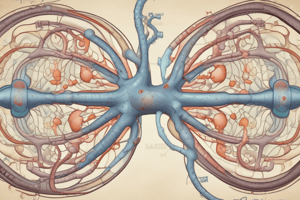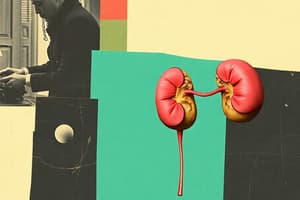Podcast
Questions and Answers
Which of the following is the primary waste product of protein breakdown in the body?
Which of the following is the primary waste product of protein breakdown in the body?
- Urea (correct)
- Creatinine
- Uric acid
- Ammonia
Plasma urea measurement is generally considered more useful than plasma creatinine measurement for assessing renal function.
Plasma urea measurement is generally considered more useful than plasma creatinine measurement for assessing renal function.
False (B)
What enzyme hydrolyzes urea in the serum urea estimation process?
What enzyme hydrolyzes urea in the serum urea estimation process?
urease
In the principle of urea estimation, free ammonia in an _______ medium forms a green-colored complex.
In the principle of urea estimation, free ammonia in an _______ medium forms a green-colored complex.
What factor is used to convert urea to blood urea nitrogen (BUN)?
What factor is used to convert urea to blood urea nitrogen (BUN)?
Lipemic specimens do not interfere with urea estimation methods.
Lipemic specimens do not interfere with urea estimation methods.
What type of water should be used to dilute a urine specimen for urea estimation?
What type of water should be used to dilute a urine specimen for urea estimation?
What is a normal serum urea range for adults less than 65 years old?
What is a normal serum urea range for adults less than 65 years old?
Increased plasma urea levels are always indicative of overhydration.
Increased plasma urea levels are always indicative of overhydration.
High protein diets can _______ plasma urea levels.
High protein diets can _______ plasma urea levels.
What best describes creatinine?
What best describes creatinine?
Creatinine excretion is primarily non-renal.
Creatinine excretion is primarily non-renal.
What reagent does creatinine react with in the creatinine assay to produce a colored complex?
What reagent does creatinine react with in the creatinine assay to produce a colored complex?
At what wavelength is the colored complex measured in the creatinine assay?
At what wavelength is the colored complex measured in the creatinine assay?
Diseases associated with muscle wasting will ______ serum creatinine levels.
Diseases associated with muscle wasting will ______ serum creatinine levels.
Which condition commonly results in increased serum creatinine levels?
Which condition commonly results in increased serum creatinine levels?
Creatinine clearance is directly proportional to the glomerular filtration rate (GFR).
Creatinine clearance is directly proportional to the glomerular filtration rate (GFR).
Match the following normal ranges with correct results:
Match the following normal ranges with correct results:
According to Report (1), what does the serum urea value of 360 mg/dl indicate for the patient?
According to Report (1), what does the serum urea value of 360 mg/dl indicate for the patient?
Ammonium __________ should not be used as anticoagulant in urea estimation.
Ammonium __________ should not be used as anticoagulant in urea estimation.
Flashcards
What is urea?
What is urea?
Urea is the main waste product of protein breakdown in the body.
Where is urea synthesized?
Where is urea synthesized?
Urea synthesis occurs in the liver; it is then transported to the kidneys for filtration and excretion through the glomerulus.
Factors affecting urea levels
Factors affecting urea levels
Several factors, including hydration levels and protein intake, can affect urea levels.
Urea estimation principle
Urea estimation principle
Signup and view all the flashcards
Urea to BUN conversion
Urea to BUN conversion
Signup and view all the flashcards
Normal serum urea range
Normal serum urea range
Signup and view all the flashcards
Normal serum BUN range
Normal serum BUN range
Signup and view all the flashcards
Normal urine (24hr) urea & BUN
Normal urine (24hr) urea & BUN
Signup and view all the flashcards
Causes of increased plasma urea
Causes of increased plasma urea
Signup and view all the flashcards
Causes of decreased plasma urea
Causes of decreased plasma urea
Signup and view all the flashcards
What is creatinine?
What is creatinine?
Signup and view all the flashcards
Creatinine excretion
Creatinine excretion
Signup and view all the flashcards
Creatinine assay principle
Creatinine assay principle
Signup and view all the flashcards
Normal serum creatinine ranges
Normal serum creatinine ranges
Signup and view all the flashcards
Causes of increased serum creatinine
Causes of increased serum creatinine
Signup and view all the flashcards
Causes of decreased serum creatinine
Causes of decreased serum creatinine
Signup and view all the flashcards
Creatinine clearance measures
Creatinine clearance measures
Signup and view all the flashcards
How is creatinine clearance detected?
How is creatinine clearance detected?
Signup and view all the flashcards
Formula for creatinine clearance
Formula for creatinine clearance
Signup and view all the flashcards
Normal creatinine clearance ranges
Normal creatinine clearance ranges
Signup and view all the flashcards
Study Notes
- Kidney function tests include assessments of blood urea and creatinine levels.
Blood Urea
- Urea is the primary waste product of protein breakdown.
- The liver synthesizes urea, which is then transported through the blood to the kidneys for filtration via the glomerulus.
- Plasma urea measurement as a renal function test is less effective compared to plasma creatinine measurement.
- Several factors, such as hydration status and protein intake affect urea levels while plasma creatinine levels are not.
- Urea is hydrolyzed by the urease enzyme to produce ammonia (NH3) and carbon dioxide (CO2).
- Free ammonia in an alkaline medium with an indicator forms a green-colored complex that is proportional to the urea concentration, and is measured at 578 nm.
- To convert urea to blood urea nitrogen (BUN), multiply the result by 0.46.
- For urine urea estimation, predilute the urine specimen 1:50 with NH3-free water.
Serum Urea Reference Values
- Adults less than 65 years: 15 – 50 mg/dL
- Adults more than 65 years: > 70 mg/dL
Serum BUN Reference Values
- Adults less than 65 years: 7 – 23.5 mg/dL
- Adults more than 65 years 7 – 33 mg/dL
- Children: 5 – 18 mg/dL
Urine (24 hours) Reference Values
- Urea: 20 – 35 g/24hr
- BUN: 9.3 – 16.5 g/24hr
Clinical Significance of Increased Plasma Urea
- Impaired kidney function.
- Decreased blood flow to the kidneys, caused by congestive heart failure, shock, stress, severe burns, obstruction of urine flow, or dehydration.
- Excessive protein breakdown or high protein diet.
Clinical Significance of Decreased Plasma Urea
- Severe liver disease.
- Malnutrition.
- Overhydration.
Creatinine
- Creatinine is a non-protein nitrogenous waste product from creatine metabolism in skeletal muscle.
- It diffuses freely throughout body water, is filtered from extracellular fluid by the kidneys, and excreted in urine.
- Creatinine excretion is mainly renal and relatively constant in the absence of disease.
- Measurement of serum or plasma creatinine is a more accurate marker of kidney function than urea.
- Creatinine reacts with picric acid in an alkaline medium to form a greenish-yellow color, measured at 520 nm.
Creatinine Assay Formula
- Creatinine concentration (mg/dL) = A(test) / A(standard) x Conc.(standard)
Creatinine Reference Ranges
- Male: 0.7 – 1.4 mg/dL
- Female: 0.6 – 1.2 mg/dL
- Children: 0.3 – 0.7 mg/dL
Clinical Significance of Increased Serum Creatinine
- Renal failure and renal dysfunction.
- Obstruction of urine outflow.
- Acute renal failure due to sudden reduced blood flow to the kidney in cases of hemorrhage or surgical emergencies.
Clinical Significance of Decreased Serum Creatinine
- Diseases associated with muscle wasting reduce creatinine levels in the blood.
Creatinine Clearance
- Creatinine clearance measures the glomerular filtration rate (GFR).
- Creatinine clearance is detected by estimating plasma and urinary creatinine in a 24-hour urine specimen.
- Proper collection of the urine specimen is essential for the accuracy of the creatinine clearance test.
Creatinine Clearance Formula
- Creatinine clearance = (Urine creatinine x Urine volume (mL)/24hr) / (Serum creatinine x 1440)
Creatinine Clearance Reference Ranges
- Male: 95 – 130 mL/min
- Female: 80 – 120 mL/min (100 ± 20 mL/min)
Studying That Suits You
Use AI to generate personalized quizzes and flashcards to suit your learning preferences.



